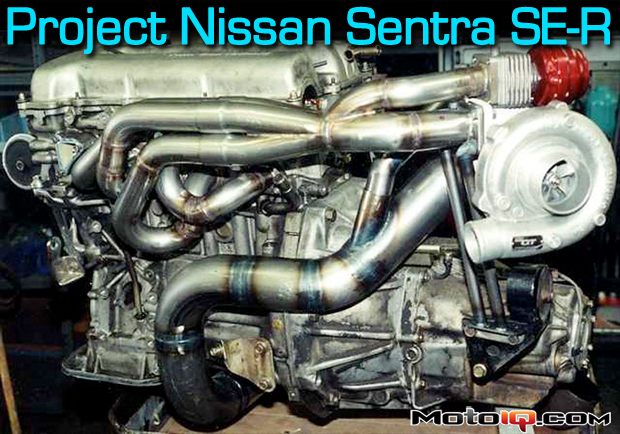,
The long runners used in this manifold have better flow and volumetric efficiency than the current log type manifolds available. The downside is that turbine efficiency of the turbo drops because of the radiated heat and expansion of exhaust gasses along the long runners before the turbine. This is one of the reasons we decided to use 304 stainless steel, because stainless steel has poorer thermal conductivity; meaning the heat stays in the exhaust stream instead of transferring to the metal. To a point heat is actually a good thing in the exhaust as it helps drive the turbine side of the turbo. According to Mike the pulse tuning and improvements in volumetric efficiency should overcome the disadvantage of using longer runners. The manifold will also receive Swain's White Lightning coating to aid further in spool of the turbine and help reduce the chance of heat soaking the engine.
 |
| The battery had to be relocated for this project to meet the required lengths for the manifold. |
One of the most important concerns with the fabrication of our manifold is durability. Better flow characteristics are great but if our manifold develops cracks or warps it will certainly put a damper on the fun. To achieve this reliability, Jhame borrowed from his experience building manifolds for dune buggies and rally cars. If his design can withstand the torture these vehicles go through, it most certainly will work in our street/road-race application. The manifold itself is supported in 3 main areas; the primaries, the collector and the flange for the turbo exhaust housing. The collector and turbo flange bracket are very strong. We did everything but stand on the manifold trying to discover a weak point. F-Max's manifold is also slip flanged meaning that the primary exhaust tubes from each cylinder are independent from the merge collector. When the exhaust heats up, the primaries expand forming a seal in the merge collector. This also relieves stress on the manifold that some folks have ridiculed as prone to breaking.
 |
| The final welds are in place so now the setup can head off to Swain Tech for thermal coatings. |
The down pipe off the turbine is full 3″ with mandrel bends. We're going to have V-Band fittings welded in when we complete our exhaust; for quick removal of the catalytic converter when we run leaded race gas at the track. On the other hand we'd like to remain emission friendly in street trim and keep our OBD equipped car happy, so ports for EGR (Exhaust Gas Recalculation) and O2 sensor have also been incorporated.
As a final step for fabrication we decided to use aluminum for our intercooler pipes. In our opinion aluminum looks great when polished, but more importantly, it will work well in conjunction with Aquamist's water injection we plan on using. Aluminum will not rust like mild steel pipes when exposed to moisture. This rationale might be slightly excessive but we'd rather not have that kind of corrosion taking place inside pipes that will see high pressures and provide air to our engine.
 |
| Test fitment in a full race b14 drag car. |
We were really impressed with F-Max's thoroughness during this process. Instead of just reconfiguring a product they currently offered, they started from the ground up, and produced a product of exceptional quality. Join us as we get close to installing these high tech parts on our project.



